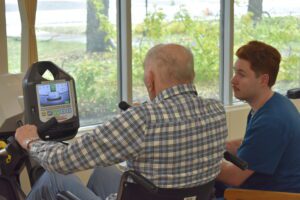A PTA’s Perspective on Rehabilitation at St. John’s Home
“Getting people back to where they were, their sense of independence, is a great joy,” says Kyle Regan, who has been working as a physical therapist assistant (PTA) at St. John’s Home for a little over 2 and half years. Starting at St. John’s in his first PT job after his course of study at Genesee Community College right at the height of the pandemic, Kyle has certainly mastered the art of being flexible.
 This flexibility serves Kyle well in the day-to-day aspects of the job. A typical day in the life of a PT professional is full of variety due to the changing nature of the clients served and the goals that they are trying to accomplish through therapy. In his role, Kyle works with both permanent residents in long-term care and consumers from the community, who have shorter lengths of stay as part of St. John’s Home rehabilitations services. With the best hours for therapy being when people are at their most energetic, Kyle’s work is focused between the hours right after breakfast to before dinner, during which time he is on the resident floors conducting sessions with the clients with whom he has been assigned to have therapy sessions with that day.
This flexibility serves Kyle well in the day-to-day aspects of the job. A typical day in the life of a PT professional is full of variety due to the changing nature of the clients served and the goals that they are trying to accomplish through therapy. In his role, Kyle works with both permanent residents in long-term care and consumers from the community, who have shorter lengths of stay as part of St. John’s Home rehabilitations services. With the best hours for therapy being when people are at their most energetic, Kyle’s work is focused between the hours right after breakfast to before dinner, during which time he is on the resident floors conducting sessions with the clients with whom he has been assigned to have therapy sessions with that day.
There are also different types of environments in which therapy can take place. Depending on the individual needs of the clients and the stage in which they are in recovery, therapy sessions can take place up on the floors of St. John’s Home in resident rooms or in St. John’s Rehabilitation Center. The center includes a spacious rehabilitation gym, with a real car, VirtuSense technology, and life skills apartment where different types of recovery goals can be achieved.
Working within the confines of the reimbursement structure for physical therapy is also another aspect of the job that requires Kyle and his peers to be creative and adaptable. “We are racing against the clock to get them (clients) back as safe and as independent as possible before going home,” says Kyle. “In a perfect setting and in a perfect world we would have as much time as was needed.”
Given this, being a PT professional requires that you be smart and strategic with what aspects of care are prioritized to ensure success according to Kyle. For Kyle, who has always wanted to work in the medical field in some capacity, however, the joys of the job more than outweigh the challenges. “I saw the benefit of the work firsthand with my loved ones,” says Kyle, who wants to be able to support of other people’s family members in that same manner.
Kyle believes it is important to emphasize that “success” looks very different for each client. Getting back “home” can range from returning to a family home out in the community to back to an assisted living apartment or independent living setting. For residents in long-term care, their goals are more focused around returning to a normal state of mobility after a recent illness or setback. Physical therapy is an important element of an interdisciplinary approach to recovery, which can also include occupational therapy, speech and language pathology, and nutrition.
And, regardless of an individual client’s goal, witnessing the determination and drive of a person working hard in therapy, is very motivating for Kyle. “It’s very rewarding to get folks back to where they want to be,” he says.
